Concerning
the
Blue China
The Baltimore and Ohio Railroad Company
Dining Car Department
In 1827, when the idea of transportation by rail was born, when a small group of enterprising business men adopted this method of bringing the trade of the rapidly growing West to the city of Baltimore, when the first charter ever drawn up for a public carrier of passengers and freight by rail was granted to the Baltimore and Ohio Railroad, these momentous events were commemorated by Enoch Wood, of Burslem, England, one of the leading manufacturers of Staffordshire china, in two beautiful blue plates stamped on the reverse --"The Baltimore and Ohio Rail Road."
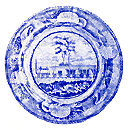 Now, for the hundredth anniversary of the founding of the Baltimore and Ohio Railroad, the blue china in use on its dining cars was especially prepared in the United States of America to celebrate this centenary birthday of the Father of American Railroads. The two souvenir plates prepared by Enoch Wood to mark the establishment of the Baltimore and Ohio in 1827 were engraved by English potters who had never seen an American locomotive, so that the train illustrated on the plate shown on the preceding page [above right] is typically British with a locomotive patterned after the illustration of Messrs. Losh and Stephenson's patent of 1816, printed in Strickland's "Report on Canals and Railroads" in 1826. No locomotive of this type was ever used in America. The inclined plane Now, for the hundredth anniversary of the founding of the Baltimore and Ohio Railroad, the blue china in use on its dining cars was especially prepared in the United States of America to celebrate this centenary birthday of the Father of American Railroads. The two souvenir plates prepared by Enoch Wood to mark the establishment of the Baltimore and Ohio in 1827 were engraved by English potters who had never seen an American locomotive, so that the train illustrated on the plate shown on the preceding page [above right] is typically British with a locomotive patterned after the illustration of Messrs. Losh and Stephenson's patent of 1816, printed in Strickland's "Report on Canals and Railroads" in 1826. No locomotive of this type was ever used in America. The inclined plane 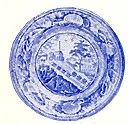 presented on the other plate shown on the opposite page [left] was, in the early days of railroading, the usual method of overcoming grades too steep for a locomotive and train to climb. In those early days the cars were pulled up and lowered down a series of inclines by cables operated by stationary engines, with a fresh locomotive waiting for the train when it reached the other side of the hill. Of course, such an arrangement was bothersome and consumed a great deal of time, so that, as the science of railroading progressed and the demand for greater speed in traveling began to be felt, the railway engineers found other ways of overcoming grades, by a longer track running more gradually around the side of the hill, by leveling the tops of the hills, or by boring tunnels through them, so that now inclined planes are not in use on railroad lines, although they still serve to carry street cars and passengers up and down hill as, for example, the inclined railways at Pittsburgh and Cincinnati. A trace of some of these old planes on the Baltimore and Ohio may be found on the Old Main Line near Ellicott City, where the first and last of a series of four inclines have furnished names to the stations still known as Plane No. I and Plane No. 4. presented on the other plate shown on the opposite page [left] was, in the early days of railroading, the usual method of overcoming grades too steep for a locomotive and train to climb. In those early days the cars were pulled up and lowered down a series of inclines by cables operated by stationary engines, with a fresh locomotive waiting for the train when it reached the other side of the hill. Of course, such an arrangement was bothersome and consumed a great deal of time, so that, as the science of railroading progressed and the demand for greater speed in traveling began to be felt, the railway engineers found other ways of overcoming grades, by a longer track running more gradually around the side of the hill, by leveling the tops of the hills, or by boring tunnels through them, so that now inclined planes are not in use on railroad lines, although they still serve to carry street cars and passengers up and down hill as, for example, the inclined railways at Pittsburgh and Cincinnati. A trace of some of these old planes on the Baltimore and Ohio may be found on the Old Main Line near Ellicott City, where the first and last of a series of four inclines have furnished names to the stations still known as Plane No. I and Plane No. 4.
In selecting the various subjects to be depicted on the new blue Centenary china, especial attention was given to the outstanding features of the Baltimore and Ohio's history and to the most representative scenic points along its lines. In the various borders is shown in historical sequence the evolution of the motive power of this particular railroad in its hundred years of progress. Advancing from the horse-drawn car, for which the road was originally designed, past the first American built locomotive, the "Tom Thumb," we come to the little "Atlantic," which was in actual service on Baltimore and Ohio tracks for more than sixty years, and can still be run under its own steam at nearly one hundred years of age. The "Philip E. Thomas," with its large smoke stack, was a familiar type of locomotive until Ross Winans designed and built in the Mount Clare shops of the Baltimore and Ohio at Baltimore, his famous camel-back locomotives, the most powerful engines of their day. The camel-back is the type which carried the Baltimore and Ohio trains with Union troops and supplies over the heavy grades of the Alleghany Mountains during the trying days of the Civil War. After the close of this war came the Mogul type, which was gradually supplanted by the more powerful Pacific, which reached its climax in the "Lord Baltimore," one of the most powerful passenger engines in the world at this time. The latter also was built in the Mount Clare shops of the Baltimore and Ohio and has the strength of two ordinary locomotives, being capable of handling the heavy trains of the Capitol and National Limiteds over the Alleghany Mountains without the aid of the customary second or "helper" engine. This forms a pageant of motive power in the border circles from the First Stone of the Baltimore and Ohio Railroad, laid on July 4, 1828, around the plates and back once more to this corner stone, as if to celebrate the anniversary year when the hundredth birthday of the railroad was reached.
For the scenes within the border there was selected, first, historic Harper's Ferry, with its scenic beauty which has entranced thousands from Thomas Jefferson down to the present day tourist on Baltimore and Ohio trains. This spot is also memorable for its story of John Brown's raid and the subsequent part the fortified heights played in Civil War history. The 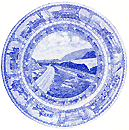 Potomac River Valley shown on the tea plate {left] is typical of many miles of the Baltimore and Ohio line which follows this historic river through the gaps it has cut in the Blue Ridge and the Alleghanies. The ancient rival of the railroad, the old Chesapeake and Ohio Canal, is shown where it, too, follows this natural path through the mountains, a path at times so narrow as to give rise to the lengthy controversies between canal and railroad for the coveted right of way. The Cheat River scene on the Potomac River Valley shown on the tea plate {left] is typical of many miles of the Baltimore and Ohio line which follows this historic river through the gaps it has cut in the Blue Ridge and the Alleghanies. The ancient rival of the railroad, the old Chesapeake and Ohio Canal, is shown where it, too, follows this natural path through the mountains, a path at times so narrow as to give rise to the lengthy controversies between canal and railroad for the coveted right of way. The Cheat River scene on the  celery trays [right] is typical of the rugged wilderness with its almost insurmountable natural barriers through which the pioneer surveyors of this pioneer railroad had to fight their way. The railroad track winds up to the crest of the Alleghanies along the side of Laurel Ridge with the Briery Mountains on the opposite bank. On the platters [below left], the beautiful scene at Indian Creek shows the junction of that stream with the historic Youghiogheny. All of the nearby country is sacred celery trays [right] is typical of the rugged wilderness with its almost insurmountable natural barriers through which the pioneer surveyors of this pioneer railroad had to fight their way. The railroad track winds up to the crest of the Alleghanies along the side of Laurel Ridge with the Briery Mountains on the opposite bank. On the platters [below left], the beautiful scene at Indian Creek shows the junction of that stream with the historic Youghiogheny. All of the nearby country is sacred 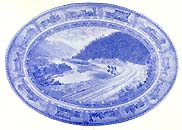 to memories of the early life of Washington and the struggles of the colonists for this territory in the French and Indian War. Near here is the site of Fort Necessity where Washington made his first and only surrender, withdrawing with all the honors of war in the face of a superior force of French and Indians on July 4, 1754. On the heights near this spot also is the grave of Braddock, the brave but stubborn English general who paid for his folly with an even more overwhelming defeat and with his life. The Narrows at Cumberland shown on the smaller platter [below right] to memories of the early life of Washington and the struggles of the colonists for this territory in the French and Indian War. Near here is the site of Fort Necessity where Washington made his first and only surrender, withdrawing with all the honors of war in the face of a superior force of French and Indians on July 4, 1754. On the heights near this spot also is the grave of Braddock, the brave but stubborn English general who paid for his folly with an even more overwhelming defeat and with his life. The Narrows at Cumberland shown on the smaller platter [below right] 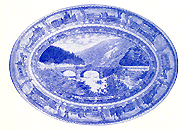 mark the gap in Wills Mountain through which Braddock and his forces marched to their defeat. It is also the gap through which many thousands of pioneers made their way westward over the Old National Pike, the original stone bridge of which is shown in the picture. mark the gap in Wills Mountain through which Braddock and his forces marched to their defeat. It is also the gap through which many thousands of pioneers made their way westward over the Old National Pike, the original stone bridge of which is shown in the picture.
The Carrollton Viaduct, shown in the small saucers [not shown here], is the oldest stone arch railroad bridge in America, being the first one built by the Baltimore and Ohio in order to carry its original line from the historic First Stone across Gwynn's Run on the old route to the Patapsco River at the Relay House. The second oldest bridge of this type is at this latter point. It is the Thomas Viaduct, pictured 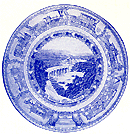 on the bread and butter plates [left] and the smallest platters. This beautiful stone arch bridge across the Patapsco River was completed in 1835 to carry the first rails of the Metropolitan Branch leading into the young Capital City of Washington. It was quite an engineering feat for its day, being built on a four-degree curve. How well the railroad's early engineers did their work is proved by the fact that this bridge, constructed for the light traffic of those early days, has been in continuous service for almost a century and shows no sign of strain under the heavy traffic loads of the present day. On the hills above the old Relay House a Federal garrison protected this vital junction point of the railway during the Civil War. on the bread and butter plates [left] and the smallest platters. This beautiful stone arch bridge across the Patapsco River was completed in 1835 to carry the first rails of the Metropolitan Branch leading into the young Capital City of Washington. It was quite an engineering feat for its day, being built on a four-degree curve. How well the railroad's early engineers did their work is proved by the fact that this bridge, constructed for the light traffic of those early days, has been in continuous service for almost a century and shows no sign of strain under the heavy traffic loads of the present day. On the hills above the old Relay House a Federal garrison protected this vital junction point of the railway during the Civil War.
The making of this special blue china has been a stupendous task and was actually under way for more than two years. In the manufacture of most sets a conventional pattern is used, one which can be repeated over and over in sections to fit the shape of the various pieces. But in this Baltimore and Ohio design there is no repetition, each border and each center scene is a complete and separate unit and was especially engraved in full detail for every kind of dish. It was necessary to do all the engraving of these copper plates by hand, since photo-engraving could not be made to produce the desired effect. The different shades of blue in the scenes are produced by making impressions on the copper plates of varying depths. For example, the shading which produces the effect of distance and perspective in the various scenes is obtained by cutting series of fine dots, carved deeper as the darker blues of the foreground are desired. There are approximately 2,600 of these dots to the square inch. The center of the dinner plate, including the view of Harper's Ferry and it's enclosing rose border, but not including the locomotive border, contains approximately 90,000 of these fine dots all carved by hand to the varying depths required for the shading. It was not only necessary to engrave all the designs freehand, but it was also found necessary, as explained above, to make fresh engravings for the center and border of every piece of different shape. It may be safely stated that never before in an American pottery have such a large number of copper plates been required for a single set. Sixteen large coppers were required for this Colonial pattern, more than four times the usual number. Three engravers, specially trained for this artistic work, devoted their whole time for a year in the preparation of the copper plates for this one set of chinaware. Even after the completion of the engravings, every piece of china requires a large amount of handwork. The engravings are printed on a thin rice paper and the wet print placed in position on the dish to be decorated, which has previously been molded and fired to the form known as the "biscuit," or more commonly the "bisque." The design is then transferred by rubbing, somewhat like a decalcomania, after which the paper is washed off and the dish is ready for glazing and firing.
To follow each article of chinaware through the factory would make an interesting story. About three months are consumed in the manufacture of each piece, thirty days of which are necessary for completing the product after printing the pattern on the bisque. Each piece requires three firings at extremely high temperatures, during any one of which it may warp or crack and have to be discarded. It is baked for approximately seventy-two hours before the pattern is printed on it, fired again for about nine hours after printing, then glazed and fired for the third and last time for from thirty-six to forty-two hours. During the firing, each piece must be kept from touching any other, so that no rough spots may mar the surface. To do this, each single piece is held in the kilns in a separate container or "sagger" with the touching edge resting on a clay base covered with a flint wash, which is too hard to fuse at the temperatures used in firing.
The deep blue color used in this china is very difficult to handle, because of its tendency to run and blur the pattern under the intense heat to which it must be exposed in producing a strong, high-grade ware suitable for dining car service. In the cheaper grades of earthenware, such as is found in the old Staffordshire, the dishes are only fired to about one-fourth the temperatures required here, and the color can be handled more readily. But that kind of soft china chips and cracks very easily and cannot stand the strain of dining car service. While modern in texture the new china follows closely in style that of the old Staffordshire china and is particularly appropriate for use in the twenty dining cars which The Baltimore and Ohio Railroad Company has had built and furnished in American Colonial style. While the task was found greater than anyone imagined in advance, it is felt that the final result in this dinner set of blue china, especially prepared for your use as a guest in a Colonial dining car of the Baltimore and Ohio Railroad, is a fitting commemoration of the hundredth anniversary of America's first passenger and freight railroad.
The dinner plates, packed in separate cartons, for sale as souvenirs, may be secured from the stewards of dining cars, at $1.00 each.
For information in relation to purchase of any of the other pieces (prices listed below), please communicate with the Manager Dining Car and Commissary Department, Baltimore, Md., or during the period of "A Century Of Progress" Exposition at Chicago, May 27-Nov. 1, 1933, orders may be left in the Office at the B. & O. Exhibit in the Travel and Transport Building.
This booklet was prepared originally for the Baltimore and Ohio Centenary Exhibition and Pageant held in 1927, Baltimore, Md., which was known as the "Fair of the Iron Horse," and has been reprinted in connection with the Company's exhibits at A Century of Progress, at Chicago, 1933.
Prices |
| Bakers-Large |
.70 |
|
Pitcher-2 Qt |
2.65 |
| Bakers-Small |
.60 |
|
Pitcher-12 Oz |
1.35 |
| Bakers-Medium |
.65 |
|
Plates-Dinner |
1.00 |
| Butter Chips |
.20 |
|
Plates-Tea |
.75 |
| Celery Troughs |
2.35 |
|
Plates-Soup |
1.00 |
| Chocolate Pots |
2.00 |
|
Plates-Bread and Butter |
.60 |
| Compartment Plate |
3.00 |
|
Platters-Fxtra large |
3.45 |
| Comport |
3.15 |
|
Platters-Large |
3.15 |
| Cups-After Dinner |
.70 |
|
Platters-Medium |
1.70 |
| Cups-Bouillon |
.80 |
|
Platters-Small |
1.10 |
| Cups-Coffee |
,80 |
|
Saucers-After Dinner |
.30 |
| Gravy Boats |
1.40 |
|
Saucers-Coffee |
.50 |
| Ice Cream Shells |
.65 |
|
Sauce Dishes |
.45 |
| Oatmeal Bowls-Large |
.65 |
|
Tea Pots |
2.25 |
| Oatmeal Bowls-Small |
.70 |
|
|
|
|